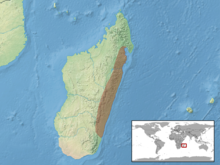Common flat-tail gecko: Difference between revisions
m Task 5: Fix CS1 deprecated coauthor parameter errors |
No edit summary |
||
| Line 21: | Line 21: | ||
A large nocturnal gecko, by day it plasters itself to a small tree trunk and rests head down. If disturbed it will raise its tail and head, open its mouth and scream.<ref name="Glaw1">{{cite book | last = Glaw| first = F.|author2=Vences, M. | title = A Fieldguide to the Amphibians and Reptiles of Madagascar| publisher = Vences & Glaw Verlag| year =1994 | location =Köln | pages =313 | isbn =3-929449-00-5 }}</ref> |
A large nocturnal gecko, by day it plasters itself to a small tree trunk and rests head down. If disturbed it will raise its tail and head, open its mouth and scream.<ref name="Glaw1">{{cite book | last = Glaw| first = F.|author2=Vences, M. | title = A Fieldguide to the Amphibians and Reptiles of Madagascar| publisher = Vences & Glaw Verlag| year =1994 | location =Köln | pages =313 | isbn =3-929449-00-5 }}</ref> |
||
Because the eyes are extremely sensitive to light, 350 times more sensitive than the human eye, the species is able to see in colors even at night.<ref>[http://news.bbc.co.uk/earth/hi/earth_news/newsid_9397000/9397503.stm Night time hunt of ghostly gecko]</ref> |
|||
==Etymology== |
==Etymology== |
||
Revision as of 22:46, 20 November 2014
| Uroplatus fimbriatus | |
|---|---|

| |
| Scientific classification | |
| Kingdom: | |
| Phylum: | |
| Class: | |
| Order: | |
| Family: | |
| Genus: | |
| Species: | U. fimbriatus
|
| Binomial name | |
| Uroplatus fimbriatus Schneider, 1797
| |

| |
Uroplatus fimbriatus (common name: Leaf-tailed Gecko) is a gecko which is found in eastern Madagascar and on the islands Nosy Bohara and Nosy Mangabe. These geckos live in tropical rain forests. They reach a total length of 330 mm.
A large nocturnal gecko, by day it plasters itself to a small tree trunk and rests head down. If disturbed it will raise its tail and head, open its mouth and scream.[2]
Because the eyes are extremely sensitive to light, 350 times more sensitive than the human eye, the species is able to see in colors even at night.[3]
Etymology
The generic name, Uroplatus, is a Latinization of two Greek words: "ourá" (οὐρά) meaning "tail" and "platys" (πλατύς) meaning "flat". Its specific name fimbriatus is the Latin word for "fringed" based upon the gecko's unique appearance of fringed skin.
Threats
Habitat destruction and deforestation in Madagascar is the primary threat to this animal's future as well as collection for the pet trade.[4] The World Wide Fund for Nature (WWF) lists all of the Uroplatus species on their "Top ten most wanted species list" of animals threatened by illegal wildlife trade, because of it "being captured and sold at alarming rates for the international pet trade". It is a CITES Appendix 2 protected animal.[4]
Gallery
-
Giant Leaf tail Gecko
-
Leaf Tailed Gecko
-
Leaf Tailed Gecko - from below
-
The underside of the Leaf Tailed Gecko clinging to glass
References
- ^ IUCN Red List, retrieved 16 February 2012
- ^ Glaw, F.; Vences, M. (1994). A Fieldguide to the Amphibians and Reptiles of Madagascar. Köln: Vences & Glaw Verlag. p. 313. ISBN 3-929449-00-5.
- ^ Night time hunt of ghostly gecko
- ^ a b "Inclusion of Uroplatus spp. in Appendix II" (pdf). Technical comments in support of amendments to CITES appendices submitted by Madagascar. CITES. 2004. Retrieved 2 November 2008.





